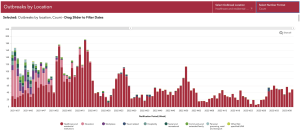In this article, we explore how Telehealth Reduces the Spread of Viruses.
Winter Respiratory Illnesses
Flus and respiratory illnesses are more common in colder months as people are indoors more often and viruses can pass more easily from one person to the next. Healthcare settings such as hospitals and nursing homes are particularly prey to this spread as can be seen from the latest Health Protection Surveillance Centre (HPSC) profile of COVID outbreaks by location, showing the Healthcare institutions are where Covid is circulating most.
Types of respiratory illnesses
Diseases of the respiratory system are one of the main causes of death in the EU and include conditions such as chronic obstructive pulmonary disease (COPD), pneumonia or asthma. As per a Eurostat Statistics Explained report, On average in 2019, in-patients with diseases of the respiratory system spent between 5.1 days (Sweden) and 10.5 days (Czechia) in hospital.
According to WHO, COVID-19 remains an uncertain threat and new variants keep emerging. COVID-19 continues to cause infections, hospitalizations and deaths across Europe. COVID-19, influenza and RSV will be co-circulating this autumn and winter.
Influenza (flu) and COVID-19 are both contagious respiratory illnesses, caused by different viruses. COVID-19 is caused by infection with a coronavirus (SARS-CoV-2) first identified in 2019. Flu is caused by infection with an influenza virus.
Respiratory syncytial virus, or RSV, is a common seasonal respiratory virus that usually causes mild, cold-like symptoms with outbreaks occurring in the winter months. Most people recover from RSV in a week or two, but RSV can be serious, especially for infants and older adults.
There is a high chance that co-circulating RSV, influenza virus and SARS-CoV-2 will increase the risk to vulnerable populations and put pressure on EU/EEA healthcare services.
How can we reduce the risk of respiratory illnesses in winter?
To reduce the spread of respiratory viruses, the European Centre for Disease Prevention and Control recommend the promotion of good healthcare and hygienic practices in the community including
- infection prevention and control measures, particularly for vulnerable groups in healthcare facilities
- hospital preparation for an increased patient load in outpatient/inpatient settings
- Preventative vaccinations against flu and Covid-19
- staying home when ill
- good hand and respiratory hygiene
- appropriate use of face masks and ventilation of indoor spaces
- use of teleworking where possible
- avoiding crowded public spaces such as public transportation
Limited healthcare staff resources combined with a growing and ageing population means that hospital bed shortages and waiting lists are growing.
Telehealth Benefits and Reducing Spread of Viruses this winter
Remote healthcare services, virtual wards and teleconsultations can help reduce the spread of respiratory and other viruses by:
- Limiting Physical Contact – Patients can consult with healthcare professionals without coming into contact with infected individuals in crowded healthcare settings.
- Remote Triage – Healthcare professionals can assess the patient’s symptoms and advise if the patient needs to have a physical examination.
- Early Intervention and Advice – Timely medical advice can be crucial in managing and containing the spread of viruses. Teleconsultation enables individuals to seek medical advice early in the course of illness, allowing prompt intervention and reducing further transmission risks.
- Reducing the Burden on Healthcare Facilities – By handling less critical cases remotely, hospitals and clinics can focus on more critical cases, preventing overcrowding and the potential for cross-infection.
- Monitoring and Follow-up – Patients in isolation can be monitored through teleconsultations and virtual wards. Healthcare providers can check on progress, assess symptoms, and provide guidance without direct physical contact.
- Prescription Renewals – For patients with chronic ongoing illnesses, telemedicine can be used to renew prescriptions and minimise the risk of viral exposure.
- Public Health Education – Telemedicine can be used to disseminate accurate information on illness prevention. The public can be advised on proper hygiene practices, vaccination, and other strategies to reduce the spread of viruses.
- No geographical restrictions – Telehealth allows for interregional consultations, enabling healthcare experts from different regions to provide guidance and expertise without travelling. This can be particularly beneficial in a global health crises.
Note that a teleconsultation may not be suitable for all medical situations. Some conditions require in-person assessment and tests. Teleconsultation depends on having internet connectivity and the nature of the patient’s issue.
Telehealth Benefit Summary
Telehealth is instrumental in minimising the risk of virus transmission by allowing individuals to consult with healthcare professionals remotely, reducing the need for physical visits to crowded healthcare facilities. Healthcare professionals can use telehealth and teleconsultations to provide timely triage and advice, early intervention and monitoring, allowing prompt detection of symptoms and appropriate advice and treatment.
Telehealth supports public health dissemination of preventative measures, in limiting unnecessary travel and exposure to viruses
BlueEye Clinic Telehealth reduces the spread of viruses!
BlueEye Clinic is an award winning video conferencing solution from RedZinc.
Contact us today at support@blueeye.video to get your account.



